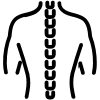Are you looking for a solution to eliminate your back pain and be more active and productive at work? Working standing at your desk could be your solution. This simple habit can transform your daily office life by reducing back pain, the harmful effects of a sedentary lifestyle on your health, and helping you be more active every day.
In this guide, we provide you with all the information you need to work standing at your desk and see the positive effects on your health and productivity for yourself.
The benefits of working standing up at the desk
Working standing up at a desk has many benefits, it allows:
- to reduce back pain,
- to improve blood circulation,
- to increase productivity,
- and stay active in the office.
Reduces your back pain
Standing at a desk can significantly reduce back pain associated with prolonged static sitting. Using a standing desk allows you to alternate between standing and sitting, which is a great way to reduce pressure on your spine. This way, you can relieve back pain and tension while remaining active at your desk.
Improves blood circulation
Long hours spent sitting at a desk can lead to heavy legs or the appearance of varicose veins. Working standing at a desk allows you to be constantly active and stimulates blood circulation by promoting better venous return. This contributes to a feeling of general well-being and better leg health.
Increases your productivity
Working standing up can also help you improve your productivity. Standing promotes concentration and engages you in your tasks.
Additionally, this position helps reduce periods of fatigue and inattention that can occur while sitting at a desk.
Finally, changing posture can boost creativity and improve problem-solving skills.
Helps you stay active at the office
Working at a standing desk, using a sit-stand desk, can help you stay active throughout the day. You can also incorporate simple exercise or stretching exercises to improve your fitness at the office and adopt a healthier, more active lifestyle.
If you want to know how to exercise discreetly or not at the office, don't hesitate to consult our articles:
- The 12 Best Office Stretches to Relieve Stress and Tension
- How to exercise discreetly at the office? Accessories and exercises
- 10 Exercises with a Ball at the Office: For an Active and Balanced Life
In short, standing at your desk has many benefits for your health, well-being, and productivity. By incorporating this practice into your daily routine, you can improve your posture, stimulate blood circulation, increase your work efficiency, and stay active throughout the day.
How to choose the right sit-stand desk?

Types of Sit-Stand Desks
There are two types of sit-stand desks to choose from depending on your needs:
- Manual sit-stand desks: Adjustable using a crank or levers, they allow you to adjust the desk height. This desk is less expensive, but also less practical than electric desks, which simply adjust the height by pressing a button.
- electric desks: they offer more comfort and flexibility.
There are also hybrid desks that are both manual and electric.
Ergonomics and adjustability
Ergonomics and adjustability are essential criteria when choosing a standing desk for working at a standing desk. First, you need to make sure the desk can be adjusted to a height that suits you and allows you to work comfortably, both sitting and standing, depending on your height and office chair.
We recommend choosing an electric or hybrid desk with easy adjustments and a locking mechanism to maintain your chosen position. Your sit-stand desk should allow you to adjust the height effortlessly and smoothly, allowing you to alternate between sitting and standing positions throughout the day.
Materials and durability
The materials used to manufacture a standing desk have a direct impact on its durability and strength. We recommend choosing a standing desk made of sturdy, durable materials, such as metal or solid wood, which ensure a long lifespan.
Also check the quality of other desk components, such as levers, cranks, adjustable feet, and work surfaces. A good standing desk should be durable and not prone to deterioration or warping.
Remember to check reviews from other buyers when making your purchase, as well as manufacturer warranties.
To choose the right standing desk for you, you need to consider the type of desk, ergonomics and adjustability, as well as construction materials and durability.
How to adjust the height of your desk?
Whether you work standing at a desk or sitting, the height of your desk should allow you to adopt good posture naturally.
What height for your desk?
When standing at a desk, your desk height should allow you to form a 90-degree angle, the same when sitting, however your feet should be flat on the floor or on a footrest and your knees should form a 90-degree angle. Adjust your desk height according to your height and personal preference to avoid poor posture and muscle tension.
Dynamic posture in standing and sitting positions
To avoid health and back problems associated with prolonged static sitting, it is important to regularly change positions by alternating between sitting and standing.
You can use accessories, such as lumbar cushions to support your lower back, and adjust the height of your office chair for optimal comfort.
When standing at your desk, use gentle movements or rocking movements to improve circulation and reduce fatigue. You can also take small steps to avoid stiffness and stay active at your desk.
To learn more about the posture you should adopt at work, don't hesitate to consult our article: Gestures and posture at work: The right reflexes to adopt.
Using dynamic seating
Using the Bloon Active Seat can significantly improve your posture and comfort at work.
Dynamic seating promotes gentle movement and improved posture in a natural way. It helps strengthen your core, abdominal, and back muscles while you sit.
Bloon Active Seating has many benefits, such as improving posture, reducing back pain, increasing productivity, preventing musculoskeletal disorders, reducing stress and improving well-being.

We recommend the Bloon Active Seat, which, in addition to being an ergonomic office ball chair, allows you to exercise at the office at any time and fits perfectly into any office design. To learn more, read our article: Bloon Active Seat: The ergonomic solution for your well-being.
By following these tips for adjusting your desk height and adopting dynamic posture practices, you will contribute to increased comfort and better health at work.
To improve your productivity, health and comfort at work, consider setting up an ergonomic workstation which includes a sit-stand desk and active sitting.
Practical tips for a successful transition
Making the transition from a traditional desk to a sit-stand desk is a great way to improve your office health, but it does require some preparation. Here are some practical tips for making the transition.
Take it slow
We recommend that you work standing at your desk only for short periods of 10 to 30 minutes per hour to start getting used to standing.
Once you're used to it, you can gradually increase your time spent standing at your desk. This will allow your body to adapt without creating excessive fatigue or pain.
Pay attention to your posture
The goal of sit-stand desks and active or dynamic sitting is to naturally adopt good posture. Whether you're sitting or standing, make sure your screen is at eye level, your elbows are at about a 90-degree angle, and your feet are comfortably resting on the floor or a footrest. Adopt a dynamic posture by regularly alternating between sitting and standing.
Take active breaks
Use your transition from sitting to standing as an opportunity to incorporate more physical activity into your work.
Take regular breaks to walk, stretch, or do light exercise. This will help you avoid fatigue and stay energized throughout the day. Short, active breaks can also improve your concentration and productivity.
If you are looking for exercises to do with the Bloon active seat, check out our article: 10 exercises with a ball at the office: For an active and balanced life
Listen to your body
Listen to your body as you transition. If you experience pain or discomfort, don't hesitate to adjust your desk height or the length of your standing sessions. Remember, one size doesn't fit all; find your rhythm and the setup that works best for you.
Ultimately, standing desks offer many benefits, including improved productivity, well-being, posture, circulation, and reduced back pain. To work standing at a desk, you simply need to incorporate a sit-stand desk into your workstation and make the transition gradually.
FAQ: Working standing at a desk
What are the benefits of working standing up at a desk?
There are many benefits to working while standing at a desk, including reducing back pain, improving blood circulation, increasing productivity, and helping you stay active at work.
How do I choose my sit-stand desk?
When choosing your sit-stand desk, consider several criteria, such as the type of desk (manual, electric, or pneumatic), its ergonomics and ease of adjustment, as well as the manufacturing materials to ensure its durability. We recommend choosing a desk that is easily height-adjustable and that meets your personal needs, in terms of comfort and workspace.
How do I adjust the height of my sit-stand desk?
Your elbows should form a 90-degree angle when working in a standing or sitting position. Your computer screen should be at eye level to avoid neck strain. When sitting, make sure your feet are flat on the floor and your knees are also at a 90-degree angle.
How long can I stand at my desk per day?
We recommend starting your office work standing for short sessions of 30 to 60 minutes, then alternating between sitting and standing every hour. The long-term goal is to spend about 2 to 4 hours standing per day. You should listen to your body and adjust the duration according to your comfort.
What ergonomic equipment is useful for a sit-stand desk?
The most useful ergonomic equipment for a sit-stand desk is active seating, an anti-fatigue mat to reduce pressure on the feet and legs, a footrest to support the legs while seated, and an adjustable monitor stand to keep the screen at eye level.
Is standing work suitable for everyone?
Standing work is not suitable for everyone. People with circulatory problems, joint pain, or specific medical conditions should consult a healthcare professional before changing their work routine.
What is the difference between a manual, electric and pneumatic desk?
A manual desk is height-adjusted using cranks or levers. A manual desk is a cost-effective option but requires more effort to change position. An electric desk allows for smooth, effortless height adjustment at the touch of a button, providing greater comfort and flexibility. A pneumatic desk uses a compressed air system to adjust height; it offers faster adjustment than a manual desk and does not require a power source.
Where can I find quality sit-stand desks?
You can find quality sit-stand desks at specialty office furniture stores, online retailers like Amazon and Ikea, or directly from manufacturers like Fully, Uplift Desk, or VariDesk. We recommend reading user reviews and checking warranties to ensure product quality.
Is it good to work standing up?
Yes, working while standing has several health benefits, such as reducing the risks associated with a sedentary lifestyle, improving posture, and increasing productivity. However, it's important not to stand all day. Alternating between sitting and standing, combined with regular movement, is the key to maximizing the benefits of standing work.












